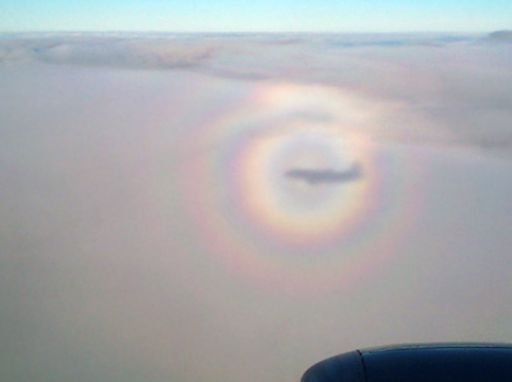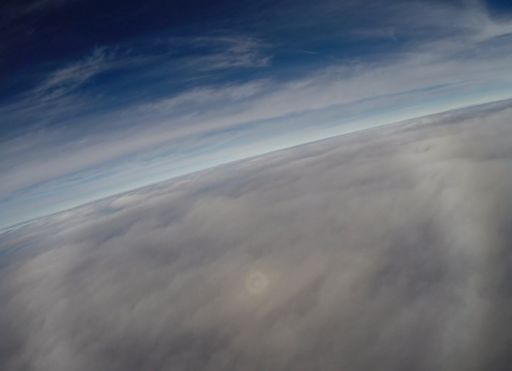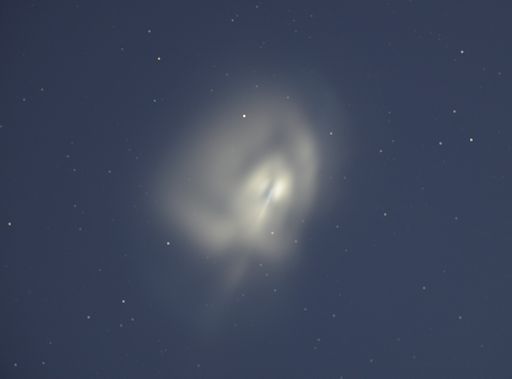Marianne's Heaven On Earth Aurora Chaser Tours Chasethelighttours.co.uk invites you to join them in their quest to find and photograph the Aurora Borealis. Experience the winter wonderland in the Tromsø Area. | | | FULL FROSTY MOON: There is a full Moon tonight, and it has a special name--the "Frosty Moon." It gets its name from northern autumnal ground frost, which glistens beautifully in pale moonlight. Go outside tonight, look up and down, and enjoy the show. [photo gallery] THANKSGIVING SKIES: Thanksgiving is the biggest travel holiday of the year in the United States. Millions of people board airplanes and fly long hours to visit friends and family. Dreading the trip? Think of it as a sky watching opportunity. There are some things you can see only through the window of an airplane, like this: 
This is called "the glory"--a bulls-eye of softly colored rings surrounding the shadow of the airplane cast on cloudtops. Atmospheric optics expert Les Cowley explains what causes it: "These rings are formed when light is scattered backwards by individual water droplets in the clouds. The more uniform the size of the droplets, the more rings you will see. They swell and contract as you travel over clouds with smaller or larger droplets." In this article, Cowley describes even more things you can see through the airplane window. Turns out, space weather balloons are another good vehicle for glory-spotting. This specimen was photographed on Nov. 21st by an Earth to Sky Calculus balloon decending over Sebago Lake, Maine: 
The shadow of the payload, which flew to the stratosphere to measure cosmic rays, is a black pinprick at the center of the bulls-eye. The large pale ring surrounding the glory is a fogbow, formed by sunlight backscattering from misty droplets 10x to 1000x smaller than raindrops. Realtime Space Weather Photo Gallery JAPANESE ROCKET SURPRISES SKY WATCHERS: Unbeknownst to most people in North America, on Nov. 24th Japan launched an H-2A rocket carrying the Telstar 12 Vantage communications satellite. The resulting display surprised sky watchers in at least half a dozen states. "I was observing Comet Catalina before sunrise, when I noticed this thing halfway up towards Venus," reports Glen Wurden of Los Alamos, New Mexico: 
"It lasted for at least a half an hour after 5:40 AM," he adds. "It was huge, easily naked eye, and kind of scary!" The cloud was a fuel dump from one of the rocket's booster stages. Lingering high in the pre-dawn sky until sunrise wiped it away, it was seen from Nevada, Arizona, New Mexico and neighboring states. Realtime Space Weather Photo Gallery
Realtime Comet Photo Gallery
Realtime Aurora Photo Gallery
Realtime Noctilucent Cloud Photo Gallery
Realtime Meteor Photo Gallery Every night, a network of NASA all-sky cameras scans the skies above the United States for meteoritic fireballs. Automated software maintained by NASA's Meteoroid Environment Office calculates their orbits, velocity, penetration depth in Earth's atmosphere and many other characteristics. Daily results are presented here on Spaceweather.com. On Nov. 25, 2015, the network reported 15 fireballs.
(14 sporadics, 1 omicron Eridanid)  In this diagram of the inner solar system, all of the fireball orbits intersect at a single point--Earth. The orbits are color-coded by velocity, from slow (red) to fast (blue). [Larger image] [movies] Potentially Hazardous Asteroids ( PHAs) are space rocks larger than approximately 100m that can come closer to Earth than 0.05 AU. None of the known PHAs is on a collision course with our planet, although astronomers are finding new ones all the time. On November 25, 2015 there were potentially hazardous asteroids. Notes: LD means "Lunar Distance." 1 LD = 384,401 km, the distance between Earth and the Moon. 1 LD also equals 0.00256 AU. MAG is the visual magnitude of the asteroid on the date of closest approach. | | Cosmic Rays in the Atmosphere | | Situation Report -- Oct. 30, 2015 | Stratospheric Radiation (+37o N) | | Cosmic ray levels are elevated (+6.1% above the Space Age median). The trend is flat. Cosmic ray levels have increased +0% in the past month. | | Sept. 06: 4.14 uSv/hr (414 uRad/hr) | | Sept. 12: 4.09 uSv/hr (409 uRad/hr) | | Sept. 23: 4.12 uSv/hr (412 uRad/hr) | | Sept. 25: 4.16 uSv/hr (416 uRad/hr) | | Sept. 27: 4.13 uSv/hr (413 uRad/hr) | | Oct. 11: 4.02 uSv/hr (402 uRad/hr) | | Oct. 22: 4.11 uSv/hr (411 uRad/hr) | These measurements are based on regular space weather balloon flights: learn more. Approximately once a week, Spaceweather.com and the students of Earth to Sky Calculus fly "space weather balloons" to the stratosphere over California. These balloons are equipped with radiation sensors that detect cosmic rays, a surprisingly "down to Earth" form of space weather. Cosmic rays can seed clouds, trigger lightning, and penetrate commercial airplanes. Our measurements show that someone flying back and forth across the continental USA, just once, can absorb as much ionizing radiation as 2 to 5 dental X-rays. Here is the data from our latest flight, Oct. 22nd: 
Radiation levels peak at the entrance to the stratosphere in a broad region called the "Pfotzer Maximum." This peak is named after physicist George Pfotzer who discovered it using balloons and Geiger tubes in the 1930s. Radiation levels there are more than 80x sea level. Note that the bottom of the Pfotzer Maximim is near 55,000 ft. This means that some high-flying aircraft are not far from the zone of maximum radiation. Indeed, according to the Oct 22th measurements, a plane flying at 45,000 feet is exposed to 2.79 uSv/hr. At that rate, a passenger would absorb about one dental X-ray's worth of radiation in about 5 hours. The radiation sensors onboard our helium balloons detect X-rays and gamma-rays in the energy range 10 keV to 20 MeV. These energies span the range of medical X-ray machines and airport security scanners. | | The official U.S. government space weather bureau | | | The first place to look for information about sundogs, pillars, rainbows and related phenomena. | | | Researchers call it a "Hubble for the sun." SDO is the most advanced solar observatory ever. | | | 3D views of the sun from NASA's Solar and Terrestrial Relations Observatory | | | Realtime and archival images of the Sun from SOHO. | | | from the NOAA Space Environment Center | | | the underlying science of space weather | | | a sponsor of SpaceWeather.com | | 
